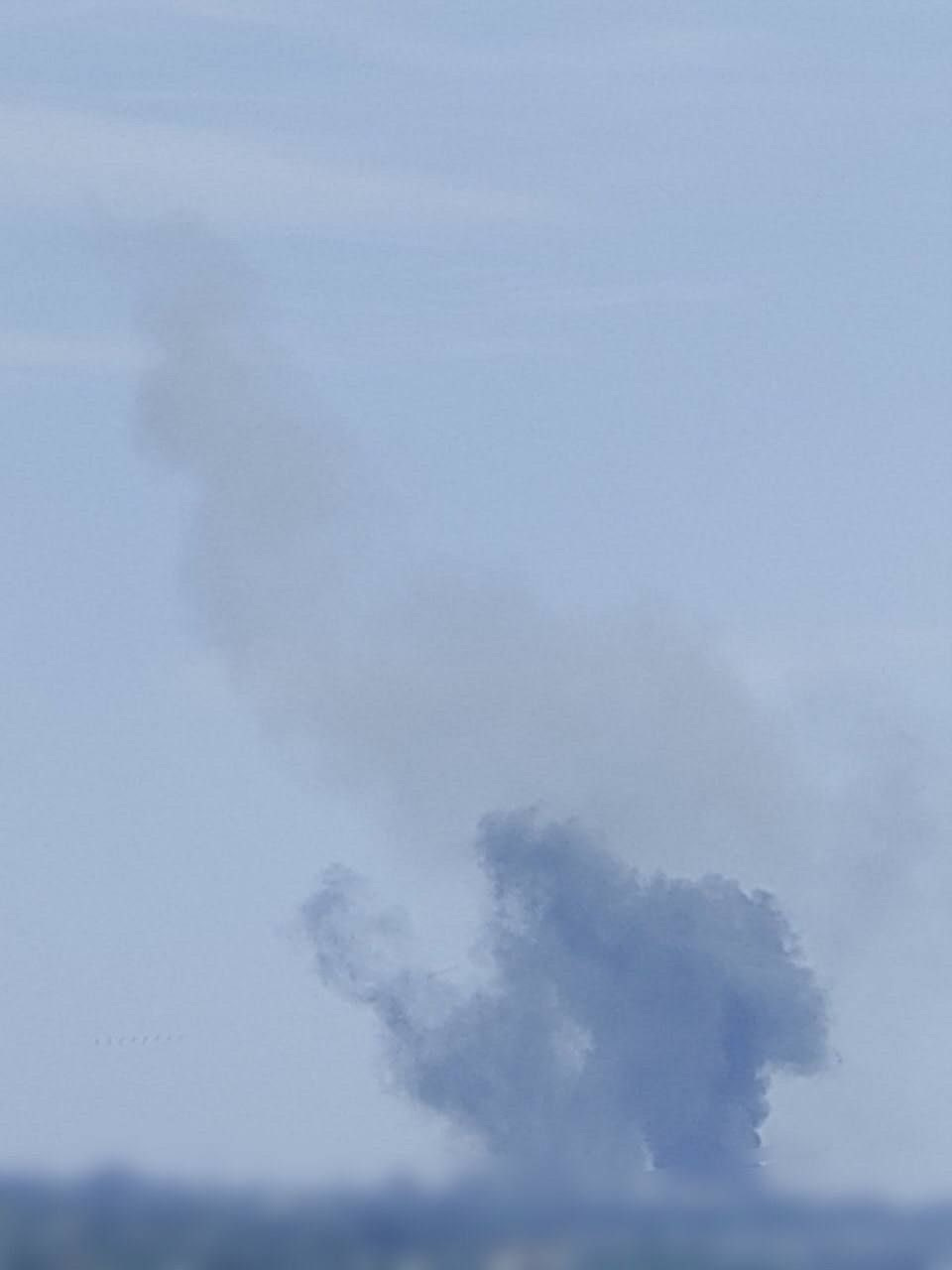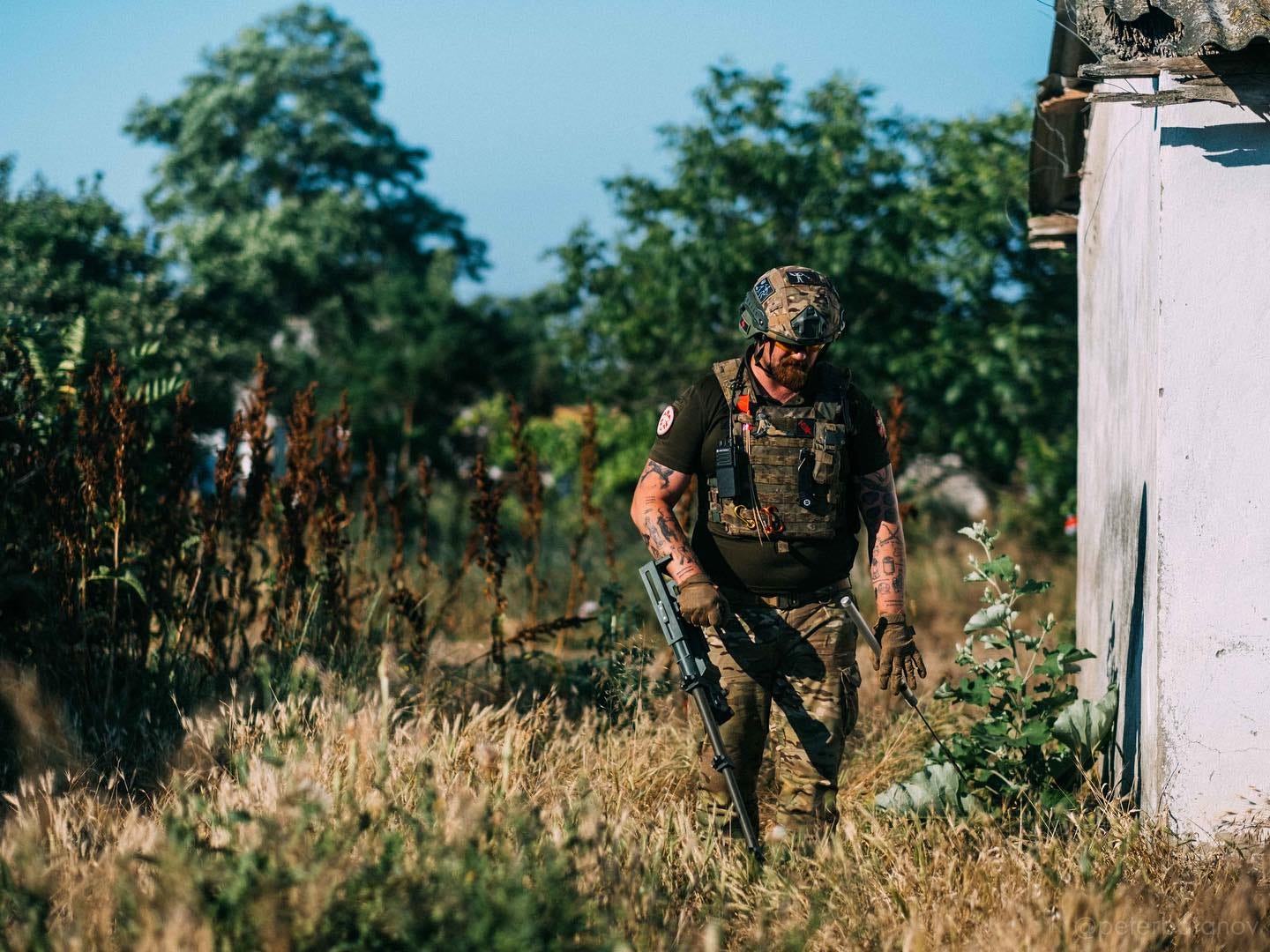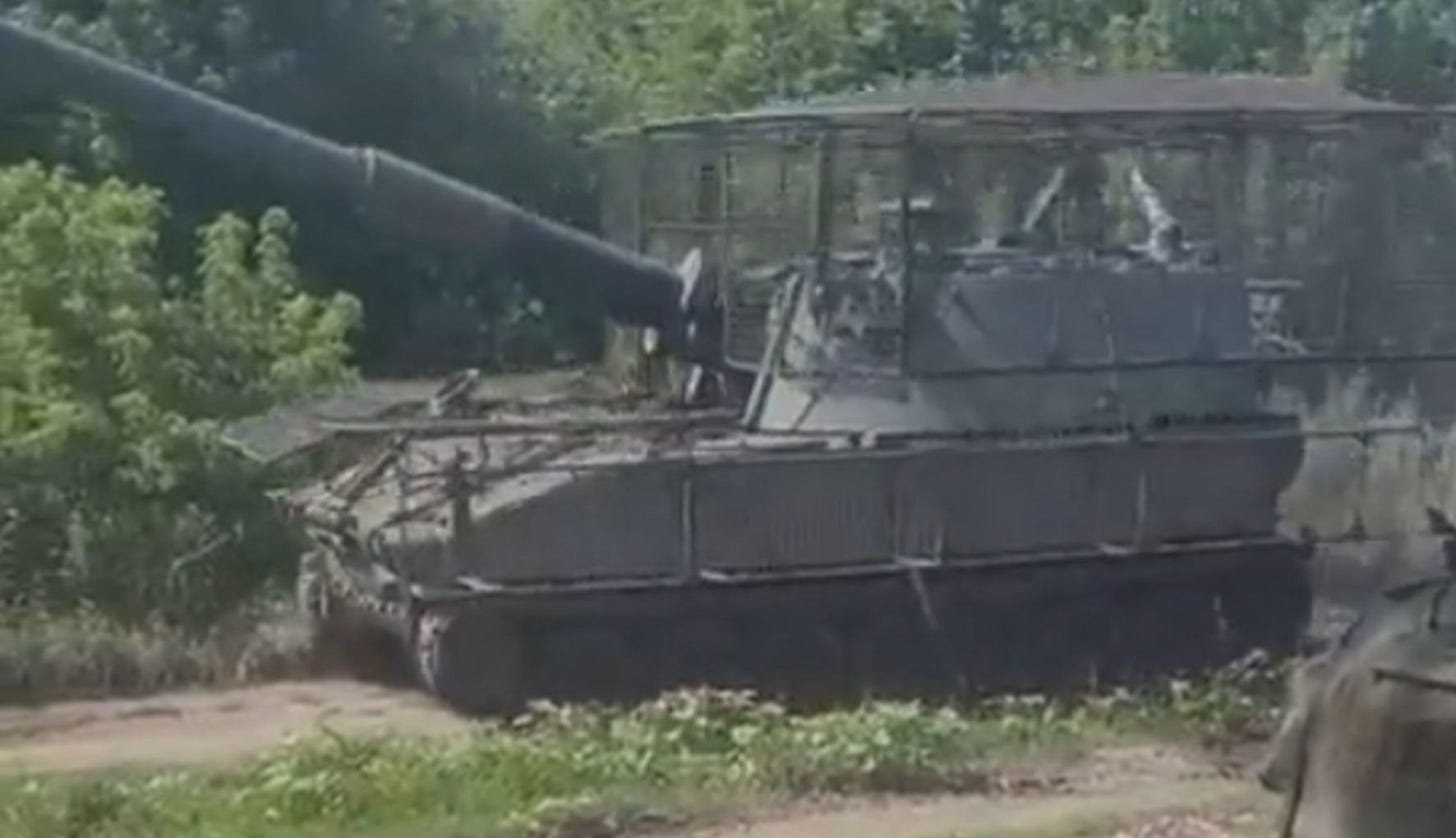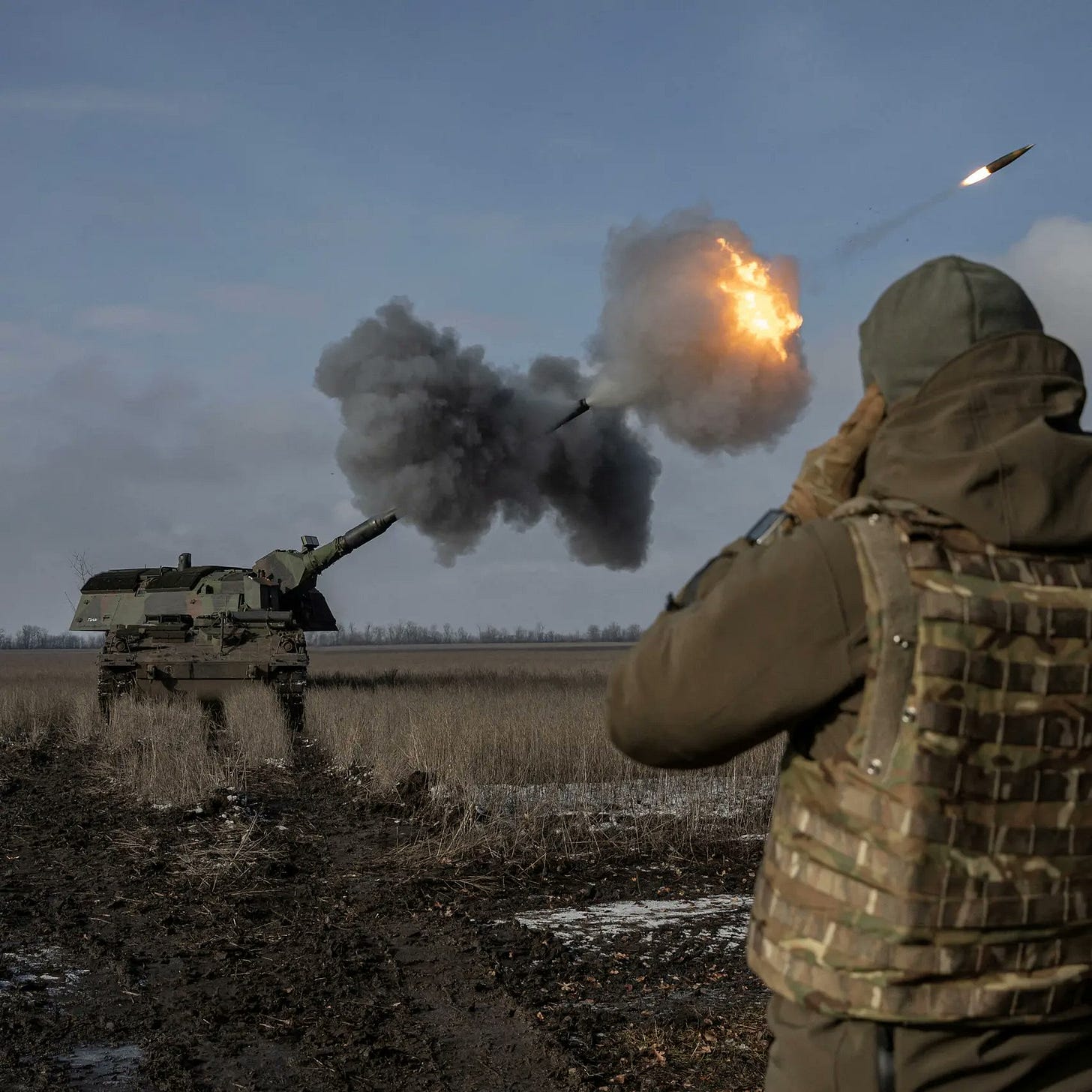Today was the Day No. 500 since Putin’s all-out invasion, and I’m at least three days ‘late’ with my next ‘regular’ update: sorry, was busy with getting a few additional books into the print (no less than two of these will be Ukraine-related, but more about this at some other opportunity). Thus, once again, I’ll ignore all of the usual political ping-pong, and get straight to what matters.
AIR/MISSILE WAR
On 4 July, the Russians targeted the centre of Pervomaisky, in the Kharkiv Oblast, with an Iskander missile. At least 31 civilians were wounded, including 10 children and 2 infants. What exactly was the VSRF targeting there: sorry, no idea.
Early on 5 July, the PSU hit a POL- and ammo-depots in Makivka (the Russians reacted with claims that the ZSU targeted the local hospital, nearby, which all proved lies: a hospital did suffer damage from overpressure and debris, though), and the administration building in the occupied Volnovakha – apparently, both by M142 HIMARS or M270 MLRS. As far as I know, this was the first Ukrainian strike with HIMARS or MLRS in the Volnovakha area. I consider that a good sign: that ‘corner’ of the frontline was something like ‘deep in the Russian backyard’ already since late February the last year.
On 6 July, the Russians attacked Ukraine with a total of 10 Kalibr cruise missiles. Seven were claimed as shot down by the PSU, but a least one demolished a number of homes in Lviv, while – apparently – missing its actual target: the local SBU HQ. On the same day, the Russians have released a video shown a Storm Shadow they’ve found. The weapon apparently malfunctioned and came down ‘almost intact’. Of course, it’s promptly declared for a great catch, ‘even if’ it ‘proved mediocre against Russian defences’.
To make sure: times when the USSR was able to rush such stuff to its ‘air defence experts’ for studies, perhaps even to its industry for reverse engineering, are long since gone. Just like the times of the USSR. Modern-day Russia simply has no means to reverse-engineer such stuff (not even the 20+ years old Storm Shadows), and Pudding is unlikely to waste ‘his’ money on such projects like when Stalin ordered the reverse-engineering of the Boeing B-29 bomber, in 1945. At most, they might try to extract chips and other pieces of hardware for use on their cruise missiles. But, sigh, this war alone is the evidence that the Russians – and all the Pudding-fans abroad – are not aware of such facts…
On the same day, at least one explosion occurred in Donetsk city, as the ZSU and PSU continued targeting additional Russian POL- and ammunition depots, including one in Yasynuvata, and another in Makivka.
Early on 7 July, the Russians released 18 Shahed-136s: 12 were claimed as shot down, but the other six came through and one did hit something in the Zaporizhzhya (city). Around the same time, Ukrainians blew up another Russian ammunition depot, this time in Sukhodolsk, in the Luhansk Oblast - and, it seems they’re now using old V-860/880 missiles of the S-200 (SA-5 Gammon) SAM-system in surface-to-surface mode, too. Indeed, the Russians claimed that one of these was intercepted by their air defences in the Kerch area.

During the night from 7 to 8 July, the Russians released a stream of Shahed-136s on Dnipropetrovsk and Kirovohrad. Five were claimed as shot down by Ukrainians, but several came through and scored hits on unknown objects.
Last night (from 8-9 July), the VSRF shelled the residential area of Kramatorsk, while in the morning the Russian air defences were reportedly ‘active’ both in the Kerch- and Rostov-na-Donu areas, and in the Bryansk area (which, apparently, was hit by one of Ukrainian V-860/V-880s).
ADD-ONs regarding DPICM SHELLS
For those with deeper interest into DPICMs, recommended read is this Twitter thread.
One example for where CBU-shells are likely to make major difference is visible on this video, shown the destruction of two Russian BM-27 launchers. It took two shells to kill them – to do the job that can be done by a single M483A1 shell.
Obviously, as soon as DPICMs appear on the battlefield, the Russians will be forced to learn to scatter their vehicles further away from each other.
BATTLE OF DONBASS
In grand total, the ‘game of chess’ is going on, with Ukrainian commanders seeking for ways to find and then exploit weaknesses in Russian lines, and the Russians reacting by closing gaps and replacing losses through pumping ever more of their reserve units to the battlefield (that said, in most of cases they seem to be taking away a battalion here and company there from units further behind the frontline, instead of sending these forward as coherent units). Where on attack (like in the Kupyansk-Svatove-Kremina sector), the Russians continue using all the firepower of their artillery and, lately, are deploying lots of tanks and infantry fighting vehicles. Where on defence, the Russians are doing everything in their powers to prevent Ukrainian breakthroughs: they’re using whatever reserves they’ve got, anything, just to prevent a manoeuvre battle. I think the reason is obvious – and something I’ve explained already: while different ‘Experten’ in the ‘West’ (better said: Central Europe) are still daydreaming about ‘high professionalism’ of the Russian Spetsnaz, the mass of Russian troops is barely good enough to defend their positions by day, and if well-supported by artillery, only. Otherwise, there’s simply no doubt that they’re poorly motivated, that their commanders are useless and having poor communications and thus poor coordination of units. In many places, they also lack well-fortified positions. But, and foremost, they know: the moment Ukrainians break through and convert the battle into one of manoeuvres, they aren’t going to be able to keep up. Neither in terms of command nor in terms of manoeuvre and firepower.
That’s why all the info on Russian ‘defence lines’ so carefully tracked down and drawn on maps of dozens of online-mappers of this war, is, actually, useless. From the Russian point of view, there’s just one defence line that matters, and that’s the forward line of contact. The very frontline. And that’s why all the fighting over the last month of this Ukrainian counteroffensive is focusing on the frontline, too.
Kupyansk-Svatove-Kremina…The Russians – which is (from north towards south):
7th Motor Rifle Regiment,
27th Guards Motor Rifle Brigade,
21st Motor Rifle Brigade,
24th Guards Spetsnaz Brigade,
55th Mountain Rifle Brigade, and
74th Guards Motor Rifle
– have spent most of the last week with continuous attempts to push west – without much success.
In the Dibrova area the VDV also continued trying to push west and south. Sure, the 7th Motor Rifle did gain some 500m against the northern flank of the 103rd TD, north-west of Kuzemivka – prompting Russians into releasing daydreams about encirclement of the Hill 190 and whatever else… until the 93rd Mech turned up, on 6 July: then the Russian party was over and they were sent back home. Something similar happened to several Russian attacks south of Kremina, too. In total, it was always the same exercise again: the Russians shelling, shelling, shelling, assaulting, getting wrecked and falling back to starting positions, then back to shelling, shelling, shelling… Actually, in some areas – Dibrova, for example – it was Ukrainians that were counterattacking, the last few days. Without much success, though.
One interesting detail from the area west of Kremina: on 6 July, the Russians claimed to have knocked out a Swedish-made CV-90 IFV in Neveske, using a Krasnopol guided shell calibre 152mm. Gauging by the video, me thinks they actually hit a different vehicle near the CV-90 parked some 20m away.
Bakhmut…. it feels like I’m analysing the fighting for this place ‘forever’ already: at least a year now…
Anyway…
Bakhmut….north….following days of reports about minor Ukrainian attacks, since yesterday, there are reports about much larger attacks from north on the area between Soledar and Yakovlivka. Also claims about an Ukrainian advance of 1,000-2,000 metres. The last I’ve heard from this area, back on 5-6 July, the 106th VDV Division suffered heavy losses (apparently, one of its battalion was almost annihilated by a salvo of M142s or M270s), and thus the Russians brought two VDV regiments as reinforcements: must admit, I expected them to go to the Berkhivka area, though…
Bakhmut…well, northern outskirts…the last few days, the 3rd Assault, the 24th Assault Battalion Aidar (5th Assault), and the 57th Motor Rifle continued grinding into Berkhivka. There are reports they’re inside the village (again), and also have the fire-control over the M3 highway behind it. Haven’t seen any confirmation for this, yet, and all the war-mappers are drawing Ukrainians as still about 1000m away from the village, though….
Anyway, from what I get to hear from this area, the VSRF has a large number of T-72s and BMP-1 IFVs from the 68th Tank Regiment around, and enough self-propelled artillery. BMP-3s are meanwhile seen very rarely. They’ve got some good ATGM-teams, and their helicopters are a constant trouble – especially whenever Ukrainians are on advance. Worst of all, they’ve mined all of hedgerows in front, around, and often even in between their positions. Indeed – and pay attention at the new Russian perfidy – even many of their trenches are booby-trapped, nowadays…

Klishchivka-Kurdiumivka….this was a place of particularly bitter combat, the last seven days. On 2-3 July, Ukrainians (5th Assault, 22nd Mech and/or 80th Airborne?) secured the Hill 200 (that’s at least the ‘military designation’ of ‘that hill above Klishchivka’). By Tuesday, 4 July, positions of the Russian 72nd Motor Rifle north of the village collapsed and the Russians began fleeing. On 5 July, the Russians brought in the BARS-13 and the 68th Tank Regiment to prevent a collapse, while sending what’s left of the 57th Motor Rifle to counterattack south of the village. That didn’t really work because the 3rd Assault attacked into southern Klishchivka. Around the same time, the 28th Mech then crossed the Siversky Donets-Donbass Canal, caused heavy losses to the 4th and 14th Motor Rifle Brigades, and entered Kurdiumivka and Ozananivka, few kilometres further south.
At least it’s so that through 6 July, Ukrainians consolidated all of their newly-won positions, while the Russians spent that and the following day by bringing yet additional reinforcements to the combat zone (the 80th Motor Rifle Regiment and the 1307th Motor Rifle Battalion, just for example).
Avdiivka & Mariinka….the, reportedly, heaviest Russian assaults of the last week took place on 2-3-4 July in the area between Avdiivka and Mariinka, especially from Pisky on Pervomaiske, and in western Marinka. That said, except for ‘particularly heavy attacks’, Ukrainian videos of 10-hours-long trench fights, and the Russian complaints about ‘additional meat attacks’, neither side released lots of details. As far as can be said by now, the VSRF attacked with a total of some two motor rifle regiments and one mechanised brigade, but every single of few dozens of assaults failed – and this although receiving significant artillery support, and some 20-30 air strikes by Su-25s a day. Cannot but agree with Girkin: this is looking like if the Russian I Army Corps is keen to destroy whatever is left of ‘Separatist’ units (and those of unlucky Russian mobiks, used to ‘refill’ the same).
SOUTHERN ZAPORIZHZHYA (& SOUTH-WESTERN DONETSK)
In total, the ZSU has completely switched to its ‘commando-raid’ assault tactics. Which is: it’s infiltrating and then assaulting Russian strongholds by small groups of infantry. If these manage to approach unobserved, they’re usually overpowering- or prompting Russian garrison into panicky withdrawals. Some 15-20 minutes later, there’s then usually vicious reaction from the Russian artillery (see: shelling own positions that were lost). This in turn is enabling Ukrainian artillery (as far as this has enough shells), HIMARS/MLRS’, and/or the PSU (MiG-29s with JDAM-ERs) to hit the Russian artillery pieces. If they’re successful in this, Ukrainians then rush to reinforce their penetration, while the Russians are rushing their reserves forward and counterattacking.
The outcome usually depends on quality of command and training. Some of ZSU units are simply better at this, others are still learning their lessons and thus experiencing bigger problems and – sometimes – higher losses, too. Unsurprisingly, there are people within ranks of ZSU officers, wondering about the sense and purpose of assigning all the new weapons systems of Western origins to newly-established units, instead to ‘old’ and combat-proven ones…

Orikhiv… I think it can be said the week began with the ZSU widening its frontline by attacking Nestrianka (south-west of Orikhiv, defended by the 503rd Motor Rifle Regiment), and reinforcing its push on Verbove, so to force the Russians to thin out their units where it matters the most. Instead the Russians reacted by bringing the 1430th Motor Rifle Regiment from Novoprokopivka to counterattack and recover positions of the mauled 70th Motor Rifle Regiment, north-west of Robotyne. Didn’t really work, for either side. For the Russians because Ukrainian air strikes with JDAM-ERs have decimated the supporting artillery. For Ukrainians, because fresh Russian troops were in the way. That said, Ukrainians didn’t sit down to cry, but attacked the hill north-east of Kopani (where they’ve reached the 2nd Russian Defence Line), defended by the BARS-11 and the Tsar Wolves PMC, ‘instead’. From there, Ukrainians turned east, and drove into the western flank of the Russian defences of Robotyne, causing heavy losses to the 291st Motor Rifle Regiment. Latest news is that the ZSU then ‘penetrated’ (or, more likely: raided) positions of the 70th Motor Rifle Regiment, causing it yet additional heavy losses before being stopped by a severe thunderstorm, yesterday.
Perhaps more importantly: the VSRF losses in this area have reached a point where the Russians are meanwhile bringing their next – and last – operational reserve in southern Zaporizhzhya, the 35th CAA, to the area between Novoprokopivka and Basan. Which is just as good, because this is now blasted by Ukrainian artillery.
BTW No.1: just how effective the ‘commando raids’ by the ZSU infantry can get, is obvious from what these survivors of the company that used to defend Novodarivka, until 1-2 July, have to say. Over 50% casualties…
BTW No. 2: of interest is that the VKS is all the time bombing Mala Tokmachka with MPKs and UMPKs, plus BM-27s and BM-30s, and by Lancets, and that the village is intensively monitored by the Russian UAVs. Apparently, it was in this area that the ZSU suffered its first confirmed loss of a British-made AS-90 self-propelled howitzer. At the same time, Ukrainians are reporting a strong concentration of Russian forces in Kermenchik: supposedly, these have grouped a tank battalion and something like 3-5 motor rifle battalions there. Whether for some sort of counterattack, or in expectation of a bigger Ukrainian assault in that direction – no idea. We’re going to see. I’m just sure of one thing: ‘big trenches and anti-tank obstacles’ are NOT marking anything like ‘1st Russian Defence Line’. The 1st Defence Line is on the frontline. Everything further behind was constructed as, a) Maskirovka, and b) ‘fall-back-line’. I.e. these long lines of trenches are the ‘2nd Line’; one to which the VSRF is planning to withdraw when its 1st Line collapses. Which in turn confirms that one can’t measure the ZSU’s advance by how much of any kind of ‘trench line’ has it reached, i.e. how many kilometres did it advance: the only way to measure it success right now is by how much damage is it causing to the Russians. How many of these are getting killed, how many vehicles and guns destroyed…

Staromaiorske-Staromlynivka…the ZSU’s grinding through the forest between Pryyutne and Staromaiorske is starting to pay off: since some 3-4 days, Ukrainians are squeezing Pryyutne from both west (36th Naval Infantry) and east (31st Mech), and attacking what’s left of the 60th Motor Rifle Brigade VSRF in the Staromaiorske-Urozhaine conglomeration both from west (35th Naval Infantry) and east (35th Naval Infantry and 4th Tank). They seem to be at least on the verge of Pryyutne, if not already inside (think to have seen a video shown a sizeable depot of mortar ammo, captured there….can’t find the link any more). Indeed, I was expecting them to liberate this place by now; instead, the Russians claimed to have counterattacked the place, on 8 July, and thus the fighting is still going on.
In the case of Staromaiorske: it appears that the ZSU is not trying to directly assault the place. Thanks to possession of high grounds west of the latter village, the place became perfect to continue smashing the defending Russians – and all the reinforcements they’re still sending there in big numbers. Fine with the ZSU, I would say.
Further east, Ukrainians (37th Naval Infantry) have also resumed their attacks on Novodonetske and Kermenchyk.
Notably, through all this time, the Russian command is not moving the 336th Guards Naval Infantry Brigade from Volodyne, where this is sitting, doing nothing, and waiting for over a month, already. This is unusual for the recent style of the Russian command: after all, three weeks ago they’ve rushed most of the 127th Motor Rifle Division northwards, in attempt to save the situation in this area. But, now it seems somebody there is not sure his/their lines further north are going to hold out for much longer?
That’s about all coming to my mind right now. Of course, there was fighting in plenty of other areas - especially, apparently, in the Oleshky area, where the Russians failed to destroy the Ukrainian bridgehead, but continue pounding it by all the mans on their hand. But, I think I’ve caught all the ‘most important’ developments of the last week.





Very thorough and illustrative. Thanks, Tom.
Most possibly target of 6 Jul attack in Lviv wasn't SBU HQ (which was targeted a week before) but one of nearby military facilities - Academy of ground forces or base of 24th OMBr. Both have a few of garages on their territories, which possibly could be used for holding some vechicles (but i have big doubts they did so). Anywhere, rockets missed both and hit nearby living building.